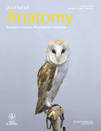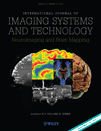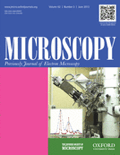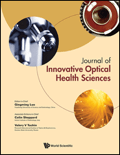
MICROSCOPY RESEARCH AND TECHNIQUE
metrics 2024
Exploring the depths of life sciences through microscopy.
Introduction
Microscopy Research and Technique, published by Wiley, is a leading journal in the field of microscopy, emphasizing innovative research and advancements in both techniques and applications. With an ISSN of 1059-910X, this journal caters to a diverse audience, including researchers, professionals, and students, and spans various disciplines such as anatomy, histology, and medical laboratory technology. As evidenced by its impressive 2023 ranking in Scopus, placed in the top quartile for Anatomy and Medical Laboratory Technology, the journal continues to play a pivotal role in enhancing the understanding of microscopic techniques and their applications in life sciences. While it does not currently offer open access, the journal’s content is invaluable for those in the research community seeking to remain at the forefront of microscopy advancements. Covering a broad range of topics from basic research to clinical applications, Microscopy Research and Technique is a vital resource for anyone involved in scientific discovery through microscopy.
Metrics 2024
 0.44
0.44 2.00
2.00 2.20
2.20 131
131Metrics History
Rank 2024
Scopus
IF (Web Of Science)
JCI (Web Of Science)
Quartile History
Similar Journals

JOURNAL OF DIGITAL IMAGING
Transforming Insights into Digital Imaging ExcellenceJOURNAL OF DIGITAL IMAGING, published by Springer, is a premier journal dedicated to the field of digital imaging, encompassing significant developments in the intersecting disciplines of radiology, computer science applications, and ultrasound technology. With its impressive Q1 ranking in the categories of Radiology, Nuclear Medicine and Imaging, and Radiological and Ultrasound Technology, and a substantial Q2 ranking in Computer Science Applications, this journal is positioned at the forefront of research dissemination in these vital areas. The ISSN 0897-1889 and E-ISSN 1618-727X signify its broad reach and accessibility, while its Scopus rankings demonstrate its robust impact in the academic community, ranked #41/333 in Radiology and earning a notable 87th percentile status. Since its inception in 1988, the journal has served as a vital resource for researchers and professionals seeking to advance their understanding of digital imaging technologies and their applications. Although it does not currently offer open access options, it continues to foster scholarly dialogue and innovation, making it an indispensable platform for those committed to excellence in imaging science and technology.

JOURNAL OF ANATOMY
Championing High-Impact Research in AnatomyThe JOURNAL OF ANATOMY, published by Wiley, is a premier international journal dedicated to advancing the field of anatomy and its related disciplines. With the ISSN 0021-8782 and E-ISSN 1469-7580, this esteemed journal has been at the forefront of anatomical research since its inception in 1945. Renowned for its rigorous peer-review process, the journal has earned a prestigious impact factor reflecting its high standard of scholarly work. This includes a 2023 Quartile ranking of Q1 in Anatomy, underscoring its prominence among top-tier publications. The journal’s diverse scope encompasses key fields such as cell biology, developmental biology, and molecular biology, making it an essential resource for researchers and practitioners alike. Publishing cutting-edge research and reviews, the JOURNAL OF ANATOMY aims to foster innovative scientific discourse and exploration within the anatomical sciences, solidifying its role as a vital hub for the global anatomical community.

INTERNATIONAL JOURNAL OF IMAGING SYSTEMS AND TECHNOLOGY
Transforming Ideas into Imaging SolutionsINTERNATIONAL JOURNAL OF IMAGING SYSTEMS AND TECHNOLOGY, published by Wiley, is a leading journal dedicated to advancing the field of imaging systems and technologies. With an ISSN of 0899-9457 and E-ISSN 1098-1098, this esteemed journal offers a platform for high-quality research spanning essential interdisciplinary areas, including Biomedical Engineering, Computer Science, and Health Informatics. Recognized for its impactful contributions, it holds a commendable position in the Q2 quartile across multiple categories as of 2023. The journal boasts an excellent Scopus ranking, with notable acknowledgments like rank #49 out of 333 in Radiology, Nuclear Medicine, and Imaging, showcasing its relevance and importance in the academic community. Publishes annually from 1989 to 2024, it aims to bridge gaps in knowledge and foster innovative developments through rigorous peer-reviewed articles. Though it operates under a traditional access model, the journal maintains an accessible repository of cutting-edge research, making it indispensable for researchers, professionals, and students alike seeking to stay at the forefront of imaging technology advancements.

JOURNAL OF MATERIALS SCIENCE-MATERIALS IN MEDICINE
Innovating the Future of Healthcare through Materials ScienceJOURNAL OF MATERIALS SCIENCE-MATERIALS IN MEDICINE is a leading peer-reviewed journal published by Springer, dedicated to advancing the field of biomedical materials science. With an ISSN of 0957-4530 and E-ISSN 1573-4838, this Open Access journal has been committed to providing researchers and professionals with freely accessible, high-quality research since 2021. It features an extensive scope spanning bioengineering, biomaterials, biomedical engineering, and biophysics, reflecting its significant impact within these interdisciplinary domains. Recognized within the Q2 category of the 2023 rankings in multiple fields, the journal proudly positions itself as a crucial resource for innovative materials that contribute to advancements in medical applications. With impressive Scopus rankings, including 26th in Biophysics and 40th in Materials Science for Biomaterials, researchers, students, and industry professionals alike can rely on this publication for cutting-edge insights that drive the future of medical materials and technologies. Based in Dordrecht, Netherlands, the journal provides a vibrant platform for sharing groundbreaking discoveries and fostering collaborative research among a global audience.

Optics is a pioneering open access journal published by MDPI, dedicated to advancing the field of optics and photonics. Since its inception in 2020, the journal has fostered the dissemination of high-quality research and innovative developments in optical sciences, contributing significantly to its community of researchers, professionals, and students in Switzerland and beyond. With an impact factor reflective of its growing prominence, Optics strives to address a diverse scope, encompassing atomic and molecular physics, electronic materials, and broader topics in physics and astronomy. The journal's commitment to open access ensures that cutting-edge research is freely available, promoting collaboration and knowledge-sharing across disciplines. As of 2023, it holds a Q4 ranking in several categories, including Atomic and Molecular Physics, and Optics, which illustrates its evolving role in the academic landscape, positioning it as a valuable resource for those seeking to explore the frontiers of optical technology and its applications.

Nanoscale Research Letters
Connecting ideas and innovations in nanoscience.Nanoscale Research Letters, published by SPRINGER, is a leading open-access journal dedicated to the rapid dissemination of innovative research in the field of nanoscience and nanotechnology. Established in 2006, this journal provides researchers and professionals with a platform to share their groundbreaking findings across a broad spectrum of applications, including condensed matter physics and materials science. With an impressive Q1 ranking in both Condensed Matter Physics and Materials Science categories as of 2023, it asserts its position as a top-tier publication within the scientific community, bolstered by a 96th percentile rank in the Scopus database. Nanoscale Research Letters not only emphasizes the importance of nanotechnology research but also ensures that its findings are widely accessible, adhering to its open-access mandate. Scholars and students alike are encouraged to contribute to and engage with this dynamic resource, fostering collaboration and innovation in the ever-evolving world of nanoscience.

Microscopy
Illuminating the Future of Imaging and AnalysisMicroscopy, published by Oxford University Press, is a prestigious journal dedicated to advancing the field of microscopy and imaging in biological and applied sciences. With a dynamic coverage dating from 1953 to the present, it offers vital insights into the latest techniques and applications across various disciplines, including Instrumentation, Radiology, Nuclear Medicine and Imaging, and Structural Biology. The journal is recognized for its quality, illustrated by its Q2 and Q3 quartile rankings in relevant categories for 2023. Researchers, professionals, and students will find Microscopy an invaluable resource for keeping abreast of contemporary developments and methodologies in the field. As an open-access journal, it promotes equitable access to cutting-edge research and fosters collaboration among the international scientific community, making it essential reading for anyone involved in microscopy research and its applications. For more information, please visit their site for access options and contributions.

Nanotoxicology
Decoding the Risks of Nanomaterials in Biomedical ScienceNanotoxicology is a pioneering journal published by Taylor & Francis Ltd, dedicated to the critical examination of the toxicity of nanomaterials and their implications in biomedical engineering, nanoscience, and toxicology. With an ISSN of 1743-5390 and E-ISSN of 1743-5404, this journal has established itself as a significant player in its field since its inception in 2007. Classified within the Q2 category for 2023 in major categories such as Biomedical Engineering, Nanoscience and Nanotechnology, and Toxicology, it reflects its robust impact across interdisciplinary research. Notably, its Scopus rankings position it in the top percentile, underscoring its influence in pharmacology and toxicology. The journal offers scholars, researchers, and professionals a platform for sharing pioneering studies and reviews, thereby advancing the understanding of nanomaterial interactions with biological systems. Published from the United Kingdom, Nanotoxicology recognizes the growing importance of nanotechnology in health and environmental contexts, making it an essential resource for anyone engaged in this rapidly evolving field.

Journal of Innovative Optical Health Sciences
Transforming Patient Care Through Optical ScienceWelcome to the Journal of Innovative Optical Health Sciences, an esteemed platform dedicated to the interdisciplinary exploration of optical technologies in health sciences. Published by World Scientific Publishing Co Pte Ltd, this open-access journal has been at the forefront of innovation since its inception in 2008, facilitating vital discussions and research advancements. With a notable impact factor and a commendable ranking in various scientific categories—including Q2 in Atomic and Molecular Physics, Q3 in Biomedical Engineering, and Q3 in Medicine (miscellaneous)—the journal serves as an essential resource for researchers, professionals, and students alike. Hailing from Singapore, we aim to bridge the gap between optical science and healthcare, promoting breakthroughs that enhance patient care and medical practices. Explore our diverse collection of studies and join a vibrant community committed to advancing knowledge in this cutting-edge field.

Progress in Biomedical Engineering
Bridging disciplines to revolutionize healthcare outcomes.Progress in Biomedical Engineering, published by IOP Publishing Ltd, is a premier open-access journal that serves as a vital platform for the dissemination of innovative research in the field of biomedical engineering. With an impressive Q1 classification in the Biomedical Engineering category for 2023, this journal has established itself as a significant contributor to the advancement of engineering solutions that improve healthcare outcomes. Recognized for its high-quality and impactful publications, it ranks 51st out of 303 in its field on Scopus, placing it in the 83rd percentile. The journal aims to foster interdisciplinary collaboration and introduce pioneering methodologies and technologies that bridge the gap between engineering and medicine. By providing a pathway for rapid communication of fundamental and applied research, Progress in Biomedical Engineering is dedicated to shaping the future of healthcare technology. Access to its content ensures that researchers, professionals, and students remain at the forefront of biomedical innovation.